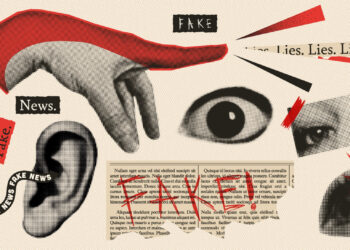Citation networks are used to calculate alternative journal performance metrics, but their real value to publishers may be found in other applications.
In a previous post, I described how Eigenfactor and SCImago Journal Rank (SJR) scores were calculated and compared these tools to citation metrics based on raw citation counts like the Impact Factor. In this post, I want to move the conversation beyond what citation networks can offer as sources of metrics and journal rankings, and talk more generally about how they can be used by journal publishers as tools for competitive intelligence.
Below is a network map I created that renders the flow of 42,500 citations made in 2014 to 68 orthopedics journals indexed in the Journal Citation Report (JCR). In this map, each journal is represented as a circle (node), the size of which is proportional to the flow of citations. Orthopedic journals are colored red, while all other citing journals are colored blue. The spatial relationship among the orthopedic journals is determined by how many citations flow between them: close proximity indicates that two or more journals frequently cite each others papers, while those farther away are much less connected. Strongly interconnected journals cluster in the center of the graph.
While I’ve dimmed them so they don’t obscure everything else, the arrows represent the flow of citations from one journal to another. The black “attaché handles” on most orthopedic journals represent self-citations–citations made by the journal to other papers published in the same journal. For purposes that will become clear in just a minute, this network map is restricted to citations made in 2014 to papers published in 2012 and 2013–the same observation window that Thomson Reuters used to calculate its 2014 Journal Impact Factors.

If we focus in on this citation map, we can learn a lot more about the relationships among orthopedics journals. First, you can see how the spine journals cluster together at the west side of the map; hand journals cluster together at the east side. The journal Injury (bottom) is in close proximity to the Journal of Orthopeedic Trauma. There are a lot of clusters that make perfect sense even by those of us who know little about orthopedics.
Nevertheless, there are journals that you would expect to cluster together but don’t, for example, why doesn’t the Journal of Foot and Ankle Research (north-east quadrant) cluster with other foot and ankle journals in the south-east quadrant? Why do some journals cluster near the center of the map while others are relegated to the periphery, largely unconnected through citations to other orthopedic journals?
Proximity and a high flow of citations between two or more journals may indicate that journals are competing for papers on particular topics, but they may also indicate a more nefarious use of citations, such as a citation cartel, or as Thomson Reuters calls it, “citation stacking.” Last year, Thomson Reuters suspended 10 journals for this behavior.
And lastly, the width of the black “attaché handle” may indicate that self-citation is being used by a journal as a strategy to inflate its Impact Factor score, especially when self-citation is focused, almost exclusively, on the previous two years of publication. Quite often, journal editors will use the Editorial as a vehicle for systematically promoting nearly every article published in the previous two years (example). Some editors will also resort to coercing authors to increase self-citations. While a pattern of high self-citation doesn’t prove intent, it is something competitors should nevertheless investigate. When self-citation rates focused on the prior two-years of publication is several times higher than the journal’s overall self-citation rate, there is usually a simple explanation.
From a strategic point of view, a network map may help editors reposition the scope of the journal. The editor of a prestigious journal may steer his/her journal into a highly-competitive, citation-rich space, knowing that realigning the journal’s scope would result in attracting the best submissions that would have been sent to a competitor. Alternatively, a editor of a less competitive journal may deliberately steer away from this fracas–knowing that it may only receive submissions rejected from other journals in these waters — to a space it knows it will perform better.
In sum, there is a lot that publishers can learn from the citation network beyond simple metrics scores. As a data reduction tool, a map can provide a lot more information to the untrained eye than simple frequency tables and journal ranks.
Discussion
5 Thoughts on "Citation Networks Yield Competitive Intelligence"
Temporal changes would be interesting to see too; e.g to track the rise of new entrants like the BMC one which is now a large player. And how established journals may move over time. So e.g do scope changes actually change much? Does much change among the more prestigious titles? Etc
Phil, very interesting work, many thanks. Since I am not familiar with the use of Gephi I have a question related on the way in which data are visualized.To the best of my understanding, the citation flow between 2 journals is the sum of the citations that journal X gives to journal Y and those that journal Y gives to journal X. If this is the case, however, in this visualization one is missing one piece of information. In general, in fact, journal X may receive a very different number of citations from journal Y than of the citations that journal X gives to journal Y. The existence (or not) of a (quasi) symmetric citation flow between the 2 journals may be important in determining the potential existence of citation cartels, especially if more than 2 journals are involved.
One way to visualize this is of course to add a link between the 2 circles representing the journals whose thickness is proportional to the citation strength. Not sure if Gephi allows this, but I would be curious to see it.
Excellent point. Citations are directional so one could scale the size/importance and position of a journal based on in-links, out-links, or both. In this case, I counted only in-links. This allowed me to count citations from all of the non-orthopedics journals (blue nodes) . In this graph, I purposely faded the directional links between journals and focused on their position; however, lose proximity between two or more journals usually entails thick arrows.
Reblogged this on Phambichha's Blog.
I am a big fan of mapping science, having developed a semantic algorithm for DOE to do just that. But the visualizations of all these maps, including citation networks, suffer from a common challenge. They are two dimensional projections of three dimensional structures. No matter how you project 3D onto 2D you will get things looking close together that are actually far apart. This makes them less than useful.

